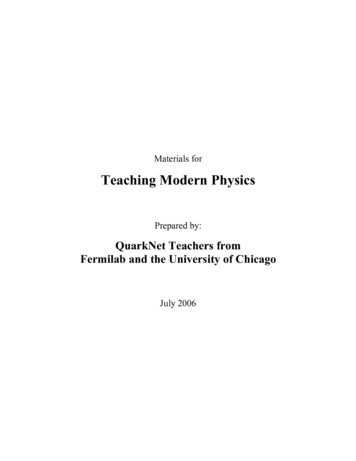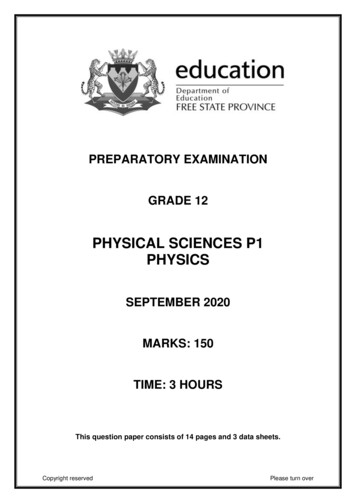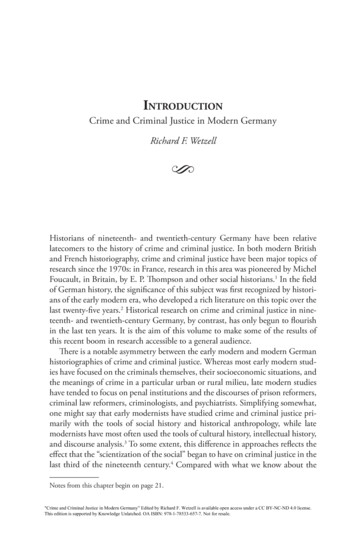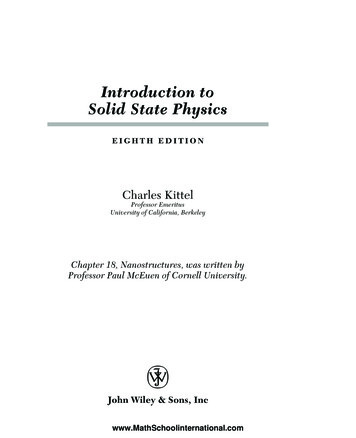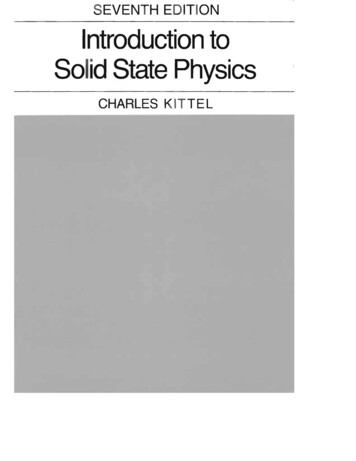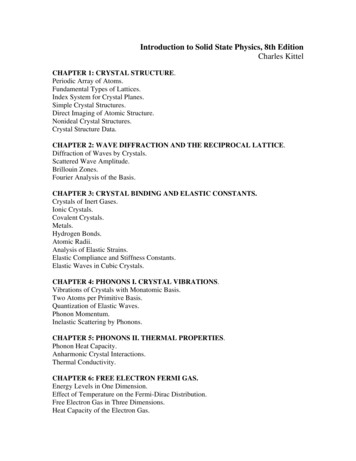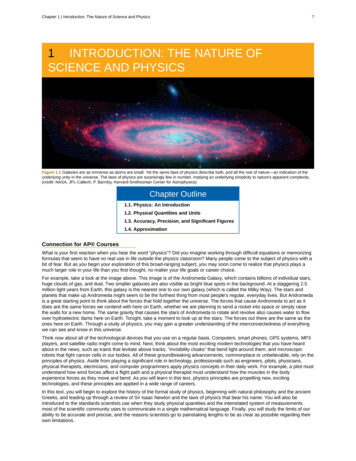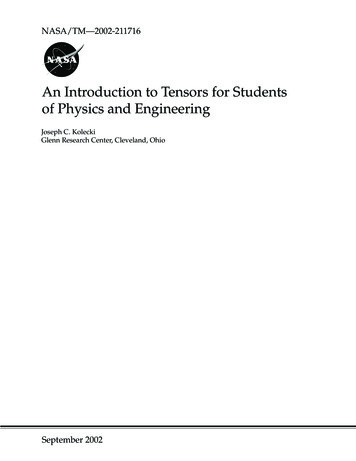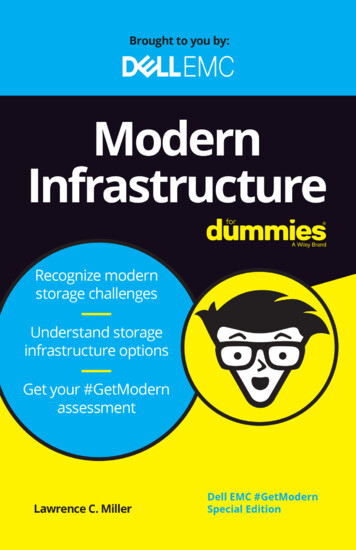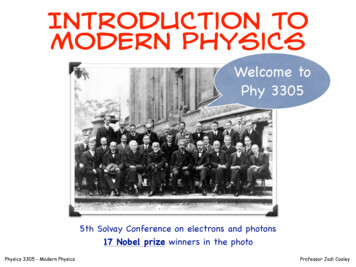
Transcription
Introduction toModern PhysicsWelcome toPhy 33055th Solvay Conference on electrons and photons17 Nobel prize winners in the photoPhysics 3305 - Modern PhysicsProfessor Jodi Cooley
SMU Honors Physics (PHYS 1010)Prof. Stephen Sekula Christopher MilkeLet us take a trip to an alien worldFirst Meeting: Aug. 22, 6:15pm, FOSC 60Free Food!PHYS 1010 www.physics.smu.edu/sekula/honors Zero-credit-hour add-on to introductoryphysics sequenceMeets once per week (6:15pm – 7:30pm)1 team-based semester-long projectEarn “Honors” designation on transcriptLearn physics by subject immersionPhysics 3305 - Modern PhysicsProfessor Jodi Cooley
AnNouncements- Reading Assignments:Chapter 1 (all) and Chapter 2.1 - 2.3- First homework assignment was given out today and isdue Tuesday, August 29th.- Read the homework policy!- Read the syllabus!- Read the hand out on sig figs!Physics 3305 - Modern PhysicsProfessor Jodi Cooley
Course InstructorProfessor Jodi CooleyOffice: 151 Fondren Sciencecooley@physics.smu.eduMr. James Thomasjamesthomas@smu.eduPhysics 3305 - Modern PhysicsProfessor Jodi Cooley
Course InstructorProfessor Jodi CooleyOffice: 151 Fondren Sciencecooley@physics.smu.eduAvailabilityCourse: Tues & Thurs. 12:30 - 1:50 pmOffice Hours:TBDFill out doodle poll by NOON on Wednesday (Aug. 22).http://doodle.com/poll/72sm895av3wk2gpnPhysics 3305 - Modern PhysicsProfessor Jodi Cooley
NOTE: This course does not use blackboard.Course extBoOkModern Physics by Randy Harris (2nd Edition)I also recommend that you consider purchasing amathematical handbook (i.e. Schaum’s Outline Series:Mathematical Handbook of Formulas and Tables byMurray R. Spiegel, 3rd. edition)Extra Credit - SeE HandoutFree one-year membership to APS gives subscription to Physics ysics 3305 - Modern PhysicsProfessor Jodi Cooley
Surgeon General’s Warninga)Too much exposure to Modern Physics may cause severe headaches,. ok not true, but: You have ALL been learning and doing classical physics for about 20 years NONE of you have had any first hand experience with modern physics Will be introduced to some counter-intuitive concepts Do not expect to be able to do the problems on the very first try. Giveit 3-4 legitimate tries before seeking help. Collaborating with classmates on solving problems is acceptable (in fact, itis encouraged!), but the solutions you hand in MUST be your own (see SMUHonor Code) No credit for late homework. Attendance: Judge for your self, . how many SMU courses were you ableto master by just staying at home and reading the book Corollary: Don’t expect to be able to brush off the course for a wholesemester and learn everything by cramming for a whole day prior to theexam, it also doesn’t work to eat burgers all semester expect to lose 10 lbsby going to the gym for 24 hrs straight?Physics 3305 - Modern PhysicsProfessor Jodi Cooley
How to Do WelLin the coursea)Do all the homework sets!b)Study in small groups (make sureyou’re contributing to the group asmuch as your absorbing from it)c)Come to classd)Don’t waste time on last minuteall-nightersPhysics 3305 - Modern PhysicsYour Grade:15% Homework5% Quizzes40% Midterm exams20 % Presentation20 % Final ExamProfessor Jodi Cooley
How to Do WelLin the courseEveryone has a chance to earn an Ain this class. There is no s 3305 - Modern PhysicsAAB BBC CC-Your Grade:15% Homework5% Quizzes40% Midterm exams20 % Presentation20 % Final ExamProfessor Jodi Cooley
ExpectationsWhat to expect from me An interesting and thoughtprovoking course Consideration and fairness(this does not mean easy!) Availability & approachabilityto talk to about anydifficulties & questionsWhat I expect from you Sincere effort Honesty Homework should follow thehomework guidelines on thecourse website. Punctuality PunctualityPhysics 3305 - Modern PhysicsProfessor Jodi Cooley
TopicsSpecial Relativity(ch 2)Atomic Physics & Spin(ch 8)The Nature of Particles(ch 3 - 4 )Statistical Physics *(ch 9)Quantum Mechanics(5 - 7)Other Topics(student presentations)* Time permittingPhysics 3305 - Modern PhysicsProfessor Jodi Cooley
What is Plagiarism?Physics 3305 - Modern PhysicsProfessor Jodi Cooley
entHandbook/HonorCodePLAGIARISM5 Intentionally or knowinglyrepresenting the words or ideas of another as one’sown in any academic exercise.5 In regards to cases of plagiarism, ignorance of therules is not an excuse. The University subscribes to thestatement on plagiarism which appears on page six ofWilliam Watt’s An American Rhetoric (1955).SPhysics 3305 - Modern PhysicsProfessor Jodi Cooley
Plagiarisma)It is plagiarism to copy your homework from theInstructor Solution Manuel.b)It is plagiarism to copy the homework from anotherstudent (current or previous).c)It is plagiarism to copy the solutions to yourhomework from google.d)Academic honesty means that you acknowledge yoursources! This includes people in your study group.I will report future incidents of plagiarism to the HonorCouncil. If you have any questions about academic honesty inthis class, please feel free to talk to me during office hours.Physics 3305 - Modern PhysicsProfessor Jodi Cooley
ThE Constitution of theHonor Council of SmUPREAMBLE AND DEFINITIONS We, the students of Southern Methodist University,with the approval of the Provost and the Dean of Student Life, establish the HonorCouncil to uphold the standards of academic integrity set forth in the Honor Code. Actspunishable under the code include, but are not limited to the following:ACADEMIC SABOTAGE Intentionally taking any action which negatively affects theacademic work of another student.CHEATING Intentionally1 using or attempting to use unauthorized materials,information, or study aids in any academic exercise2.FABRICATION Intentional and unauthorized falsification or invention of anyinformation or citation in an academic exercise3.FACILITATING ACADEMIC DISHONESTY Intentionally or knowingly helping orattempting to help another to violate any provision of the Honor Code4.PLAGIARISM5 Intentionally or knowingly representing the words or ideas of another asone’s own in any academic exercise.Physics 3305 - Modern PhysicsProfessor Jodi Cooley
Student ConductPhysics 3305 - Modern PhysicsProfessor Jodi Cooley
Details**In general you can expect the following schedule for assignments.However, you must pay attention as exam weeks and weeks whenthere are vacation days, assignment due dates may change.Tuesdays: Homework is due. Homework is assignedfor the following week. Regrade requests aredue from assignmenthanded back onprevious Thursday.Physics 3305 - Modern PhysicsThursdays: Graded homework isreturned. Regraded homework isreturned.Note: In order for a problem to qualify fora regrade, you must have made an honestattempt of the problem on the originalproblem. Abuse of the regrade system willresult in *NO* regrades for the entire class.Professor Jodi Cooley
file:///Users/cooley/Downloads/PHYS3305 OpeningCredits.medium.webmPhysics 3305 - Modern PhysicsProfessor Jodi Cooley
Newtonian PhysicsDeveloped in the 1800’s, extended forward 200 years. Force andacceleration are related to each other through inertial mass.-Kepler’s laws (accurate for many objects)-Mass was recognized as a body’s tendency to resist changesin motion (inertia).-Light identified as a wave phenomenon.Energy is a fundamental quantity that can not be created ordestroyed, only transferred.Electricity and magnetism were revealed as two faces of thesame underlying phenomenon - Electromagnetism. Allelectric and magnetic phenomenon could be described aswaves.Physics 3305 - Modern PhysicsProfessor Jodi Cooley
Newtonian physicsa)This view of the universe suggested that space and timeare the same for all observers, regardless of their stateof motion.b)Energy is different from mass and both came incontinuous units.c)All things could be predicted.-Light was identified as alternating electric and magneticwaves traveling at c 2.995 x 108 m/s. It was assumedthat light (as all EM waves) propagated in medium (theether) and was affected by the motion of that substance.Physics 3305 - Modern PhysicsProfessor Jodi Cooley
Failures of ClasSical Concepts Pions are created in high energycollisions of two protons. Theyeventually decay to muons. Situation (a): Physics 3305 - Modern PhysicsPions producedat rest in the laboratory areobserved to have an averagelifetime of 26.0 ns. (observer 1)Situation (b): Pions moving at2.737 x 108 m/s (0.913 c) havean observed lifetime of63.7 ns. (observer 2)Professor Jodi Cooley
Failures of ClasSical Concepts- Pions are created in high energycollisions of two protons. Theyeventually decay to muons.- Situation (a):Pions producedat rest in the laboratory areAccording to Newton’s Laws, time is the same for allobserved to have an averageobservers. This experimentdemonstratesthatthislifetime of 26.0 ns. (observer 1)assumption is not true!- Situation (b):Pions moving at2.737 x 108 m/s (0.913 c) havean observed lifetime of63.7 ns. (observer 2)Physics 3305 - Modern PhysicsProfessor Jodi Cooley
Failures of ClasSical Concepts Pions are created in high energycollisions of two protons. Theyeventually decay to muons. Situation (a): Distancebetween the two markers ismD1 (2.737 10)(63.7 10s8 s) 17.4 mSituation (b): Distancebetween the markers ismD1 (2.737 10)(26.0 10s8Physics 3305 - Modern Physics99s) 7.11 mProfessor Jodi Cooley
Failures of ClasSical Concepts Pions are created in high energycollisions of two protons. Theyeventually decay to muons. Situation (a): Distancethe two ismarkersisAccording to Newton’sbetweenLaws, distancethe samefor all observers. Againwefind8 m that thisD1 (2.737 10)(63.7 10 9 s) 17.4 msassumption is not true! Situation (b): Distancebetween the markers ismD1 (2.737 10)(26.0 10s8Physics 3305 - Modern Physics9s) 7.11 mProfessor Jodi Cooley
Failures of Newtonian physicsa) Michelson and Morley Experiments: Light was unaffected bythe motion of the observer. (Next class period).b)The laws of E&M appeared ‘special’ in that their form changeddepending on the state of motion of the observer (hwk 4c).c) Theory of heat failed to predict the energy emitted by ablackbody. (Chapter 3)- Heat is the thermal motion of atoms in a body.Consider heattrapped in a cavity (blackbody). The emitted spectrum ofenergy becomes infinite as the energy of radiation increases.This would cause the destruction of the universe if even oneblackbody were in existence.- Measured spectrums of real blackbodies show an increase andthen cut-off.Physics 3305 - Modern PhysicsProfessor Jodi Cooley
Modern Physicsa)Two Basic Ideas:-Time and space are not absolutes.Particles behave like waves and waves behave likeparticles.b)Two Branches:-Special RelativityQuantum Mechanicsc)With an understanding of these branches, we can thenexplore areas of modern physics such as superconductivity,modern optics, nuclear physics, particle physics andcosmology - along with a host of other areas of science.Physics 3305 - Modern PhysicsProfessor Jodi Cooley
Physics 3305 - Modern PhysicsProfessor Jodi Cooley
SpeEd of lightwalking 1 m/srunning 2-3 m/sdriving 25 m/s (highway)flying 225 m/ssound 300 m/snavigational satellite 1000 m/slight 3 x 108 m/sPhysics 3305 - Modern PhysicsProfessor Jodi Cooley
Synchronizing a SymphonyA conductor is not just part of the social construct ofan orchestra. He is required by the speed of sound andspeed of light.The distance between our ears is 22 cm. The humanauditory system is capable of discerning sounds thatare no more than 0.660 ms apart (Duplex theory). Thismeans that sounds arriving within 0.660 ms of eachother sound as if they arrive at the same time.Orchestra decides to toss the conductor.Physics 3305 - Modern PhysicsProfessor Jodi Cooley
Synchronizing a SymphonyDoes it make a difference?Say, oboe at the center of the orchestra keeps thetempo.How long does it take to reach the players at the edge ofthe pit which is 10 meters away?10 m 300 m/s 0.033 s or 33 msPlayers at the edgeare 33 ms late.Since the human ear is capable of discerning thedifference in sounds that are 0.66 ms apart, this is aproblem. The whole orchestra will be out of sync.Physics 3305 - Modern PhysicsProfessor Jodi Cooley
Synchronizing a SymphonyWhy does the conductor fix this problem?The conductor uses light, not sound, to synchronize8the orchestra. Light travels at 3 x 10 m/s whichmeans that it takes only 0.000067 ms for the playersat the back of the pit to see the hand gesture.Hence, they are only 0.000067 ms out of sync withthe players from the front of the orchestra.The human ear is only able to discern a difference of0.66 ms in sounds. So, the orchestra sounds in sync.Physics 3305 - Modern PhysicsProfessor Jodi Cooley
Thunder and LighteningThunder and lightening during in a storm are generatedat the same time. Assume that the distance between youand the source is d. Calculate the difference in time youobserve between the lightening and thunder.dtl cdandts vs1ddd d( )ts tl vscvsc11 )ts tl d(300 300, 000, 000d[s]ts tl 300Physics 3305 - Modern PhysicsProfessor Jodi Cooley
Next Time:Michelson - Morley: The downfall of the ether!Simultaneity: Will two observers always agreethat two events are simultaneous?Physics 3305 - Modern PhysicsProfessor Jodi Cooley
The End(for today)Physics 3305 - Modern PhysicsProfessor Jodi Cooley
Welcome backto PHY 3305Today’s Lecture:General RelativityAlbert Einstein1879-1955Physics 3305 - Modern PhysicsProfessor Jodi Cooley
AnNouncements-There will be no lecture video (and hence no quiz) on Tuesday,September 13th. We will be doing an in class activity that willcount towards your homework grade. We will meet in FOSC 026that day.-No reading assignment for Tuesday, September 13th.-Homework assignment 3 is due Tuesday, September 13th at thebeginning of class.-Regrades for assignment 2 are due Tuesday, September 13th atthe beginning of class.-Dr. Cooley will be out of town September 8-12th. Mr. Thomas willcover office hours that day.-Extra Credit Opportunity 1 will be due Thursday, September 29th.Physics 3305 - Modern PhysicsProfessor Jodi Cooley
Review Question 1An electron moves through the lab at 99% the speed oflight. The lab reference frame is S and the electron’sreference frame is S’. In which reference frame is theelectron’s rest mass larger?A) In frame S, the lab frame.B) In frame S’, the electron’s frame.C) It is the same in both frames.rest mass stationary energy2m E/cPhysics 3305 - Modern PhysicsProfessor Jodi Cooley
Review Question 2Are the (a) kinetic energy and (b) the total energy ofa 1 GeV electron more than, less than or equal tothose of a 1 GeV proton?The total energy of a 1 GeV electron equals thetotal energy of a 1 GeV proton. However, the restenergy of an electron is less than the rest energyof a proton. Thus, the kinetic energy of a 1 GeVelectron is greater than that of the kinetic energyof a 1 GeV proton.Physics 3305 - Modern PhysicsProfessor Jodi Cooley
Lecture Video:the Principle of EquivalenceEinstein postulated:A homogenous gravitational field is completelyequivalent to a uniformly accelerated referenceframe.-orThe form of each physical law is the same in alllocally inertial frames.Physics 3305 - Modern PhysicsProfessor Jodi Cooley
Which of the following people will observe the sameexperimental results as someone who is standing on a solidlab floor on the moon?a) An observer in a spaceship moving at constantvelocityb) An observer in an elevator on Earth movingupwards at constant velocityc) An observer in an elevator on Earth with a brokencable (i.e. in free-fall)d) An observer in an elevator on Earth movingdownwards at constant velocitye) An observer in a spaceship moving with constantaccelerationPhysics 3305 - Modern PhysicsProfessor Jodi Cooley
Deflection of Light in a Gravitational FieldObserving a beam of light in an accelerated referenceframe.Physics 3305 - Modern PhysicsProfessor Jodi Cooley
Deflection of Light in aGravitational Field-In an accelerating frame a light beams appearsto be “falling down” in a parabolic arc-According the the principle of equivalence:there is no physical difference between anaccelerating frame and a gravitational field.-Therefore a light beam will “fall down” in agravitational fieldPhysics 3305 - Modern PhysicsProfessor Jodi Cooley
Video Lecture:Gravitational LensingNote: This picture is anextreme exaggeration of theeffect known as “GravitationalLensing”If you envision space-time as afabric -- photons can not leavethe fabric.Demonstration!Physics 3305 - Modern PhysicsProfessor Jodi Cooley
Some of the most convincing evidence for dark matter comes from a phenomenon known as gravitationallensing. This was first predicted by Einstein in his theory of relativity. The theory predicts that large masses inouter space, such as clusters of galaxies, bend light that travels near them. So, as the light from a distant starpasses by a large mass, its path is distorted by gravity. Gravitational lensing was first observed experimentallyin 1919 when physicist Arthur Eddington observed light from a distant star being bent by the Sun.Some of the best evidence that we have for the existenceof dark matter comes from gravitational lensing.30Where starappears to be1. Given that the mass of the Sun is 1.99 x 10 kg and8its radius is 6.96 x 10 m, calculate the angle ofdeflection for light from a distant star that passes veryclose to the Sun’s surface.4GM2. A ray of light thatpasseswithin a distance of 16 million light years from the centre2of a cluster ofgalaxies is bent by an angledcof 2.0 x 10 radians. Use-5θgravitational lensing to calculate the mass of thecluster.dθMActualposition of star3. Order the following three scenarios according to theangle of deviation (from highest to lowest) for lightthat just passes by the edges of the clusters.Calculate the deflection of light from a distant thatapproaches very close to the surface of the sun. The4GMθ radiusdc of the sun is 6.96 x 10 m.The angle θ (measured in radians) by which light from adistant star or galaxy is bent by a mass M is given by thefollowing formula2-1122the closest thewhere G 6.67 x 10 Nm /kg , d is112 light2comes to the centre of the object, and c is the speed oflight.814a) A cluster of galaxies with a mass of 10 times the7mass of the Sun and a radius of 10 light years.14b) A cluster of galaxies with a mass of 5 x 10 times6the mass of the Sun and a radius of 3 x 10 lightyears.8cluster of galaxies with a mass of 2 x 10146 timesc) Athe mass of the Sun and a radius of 4 x 10 lightyears.4(6.67 10N · m /kg )(1.99 1030 kg)6 8.48 10rad82(6.96 10 m)(3 10 m)Convert to degrees:Physics 3305 - Modern Physics 4.86 10 2.92 104degrees2arcminProfessor Jodi Cooley
LAST TIME:Gravitational Redshift tlowerPhysics 3305 - Modern PhysicsgH thigher (1 2 )cProfessor Jodi Cooley
Relativity and GPS tlowergH thigher (1 2 )cGeneral relativity tells us that a clock runs slower when itis deeper in a gravitational field (closer Earth). So,clocks on a satellite run faster than clocks at groundlevel. In Earth’s non-uniform field .GME1 GME )] tE tsat [1 2 (crErsatApply the Physicsr distance from center of EarthA GPS satellite orbits at an altitude of 2.0 x 107 m and aspeed of 3.0 x 103 m/s. The radius of Earth is 6.4 x 106 m.a) By what fraction must the time be adjusted to accountfor both regular speed dependent and gravitational timedilation?Physics 3305 - Modern PhysicsProfessor Jodi Cooley
Speed dependent time dilationis given by t γ t0 tE !Use Binomial Expansion:1 GME1 GME )] tE tsat [1 2 (crErsat tsat tE !v21 c2 tsat 10 12 (1 1.7 10) tsat32(3.9 10 m/s)(3 108 m/s)2 tE (1 8.5 10 11) tsatGravitational time dilation of the satellite is given by(6.67 1 tE tsat [1 (82(3 10 m/s)14 m310 s2 )5.98 6.4 106 m tE (1 5.26 102410 kg 10 (6.67 14 m310 s2 )5.98 2.64 107 m1024 kg)]) tsatThe gravitational effect makes the satellite’s time larger. Its clock runs faster.The speed-dependent effect makes the satellite’s time smaller. Its clock run slower.Physics 3305 - Modern PhysicsProfessor Jodi Cooley
The fractional change is then: tE tsat 1110 (8.5 10 ) (5.26 10 ) tsat tE tsat 10 4.4 10 tsatIf this effect was not accounted for, how soon would thetime be in error be 10 ns?10 10 9 s 4.4 10tsattsat 23 sPhysics 3305 - Modern Physics10Clocks aboard GPS satellites accountfor the gravitational effect.Velocities and elevations of thereceiver units are calculated in thereceiving units.Professor Jodi Cooley
Einstein’s Postulates:1. The laws of physics areinvariant to observers indifferent inertial referenceframes.2.The speed of light is the sameto all observers, regardless oftheir motion relative to thelight source.As a consequence of Einstein’s Postulates,no information travels faster than the speed of light.This claim is supported by the Lorentz Equations!Physics 3305 - Modern PhysicsProfessor Jodi Cooley
Events simultaneous in one reference frame occur indifferent orders in another reference frame.Is it possible that the effect can precede the cause?NO!The Lorentz transformations forbid it! Events canonly be reversed if they are not causally related.Physics 3305 - Modern PhysicsProfessor Jodi Cooley
Event A occurs at space time coordinates (300 m, 2µs).A) Event B occurs at spacetime coordinates (1200 m,6 µs). Could A possible be the cause of B?Yes1200v 6 10 6Physics 3305 - Modern Physics300 m2 106s 2.3 106 m/sProfessor Jodi Cooley
Intuitive example, think of how a shadow moves.Project a shadow of your finger on a wall & wiggle it.The shadow travels faster than your finger. If youwiggle your finger at c, the shadow’s speed will appeargreater than c.Is this a violation of cause and effect?Physics 3305 - Modern PhysicsProfessor Jodi Cooley
ShadowsShadows on a wall.The misconception is that the edge of a shadow"moves" along a wall, when in actuality the change in ashadow's motion is part of a new projection, which willpropagate at the speed of light from the object ofinterference.Physics 3305 - Modern PhysicsProfessor Jodi Cooley
Television In the‘olden’ daysIn the ‘olden’ days televisions contained a picture tube, abeam of electrons sent from the back to the front (screen)by an electron gun. When the electrons strike the screen, itcauses a phosphor to glow briefly. To produce an imageacross the entire screen, the glowing beam is electricallydeflected up and down and right and left.The beam may sweep from left to right at a speed greaterthan c. Why is this not a violation of the claim that noinformation may travel faster than the speed of light?Physics 3305 - Modern PhysicsProfessor Jodi Cooley
LightSpotsThe light spots are caused by electrons hitting thephosphors, not the electrons themselves. No electrontravels from one side of the screen to the other.Nothing that can have information about the left-handside of the screen moves to the right-hand side of thescreen. The events (electrons hitting phosphors) are allplanned ahead of time and have no effect upon onanother. Thus, no information travels faster than c.Physics 3305 - Modern PhysicsProfessor Jodi Cooley
Review ProblemA plank, fixed to a sled at rest in frame S, is of length L0and makes an angle Θ0 with the x-axis. Later, the sledzooms through frame S at a constant speed v parallel tothe x-axis. Derive an expression for the length of theplank and the angle it makes with the x-axis according toan observer who remains at rest in frame S. Simplify sothat your final expression for L is in terms of cosΘ0 andyour final expression for Θ is in terms of tanΘ0.Physics 3305 - Modern PhysicsProfessor Jodi Cooley
LxLo cosx θ o L1o cos vθ2 o c 21 v c1 v 2 1 c2 v cy γ tan θo. As the speed increases, the angle θ seen by an observer in S increases. This makes sense in view oftan θo. As the speed increases, the angle θ seen by an observer in S increases. This makes sense in view ofthe fact that the faster the relative motion, the shorter the x component of the plank will be. The y componentact that thedoesnCtfaster change,the relativeshorter the x component of the plank will be. The y componentso themotion,angle is thelarger.Original:Later:nCt change, so the angle is larger.x2.39If it can pass through according to one observer it must be able to pass through according to the other! Therecannot be a collision in one frame and not in the other! ItCs just a matter of when. One argument is that itscan pass throughaccordingto onetoobserverit mustbe ableto nsperpendicularthe directionof relativemotiondonCtthroughchange[itsheight isin eitherot be a collisionin onenot inistheItCs seesjust aa plankmatterwhen. Oneitsat restAnna,so it cannothit. frameAnotherandargumentthatother!while Bobandofdoorwayat the argumentsame angleisθ, thatwith respecttotothethedirectionplank, seesofarelativeplank at motiona smallerdonCtangle,θ0. She alsoheightsees a wallher,contractedensions perpendicularchange[itsis themovingsame towardin eitherframe,′Bobandseesθ seenby Bob.The topwill passthe directionmotionthereforeat anda largerangle thanθ, Anna,at restcannot hit. alongAnotherargumentofisrelativethat whilea plankdoorwayat thethesameangle00y passes through at time zero on both clocks. According to Bob, the topthroughfirst!LetCssay thatbottomrespect to theplank,seesa plankat athesmallerangle, θ0. She also sees a wall moving toward her, contractedwill also (simultaneously) pass through at time zero: t 0. It canCt according to Anna! The top passing throughg the directionof relative motion and therefore at a larger angle than the θ seen by Bob. The top will passvvvugh first! clocks.AccordingtoBob,thetop′′t′ 2 L0(an event) occurs at t 0 and at x′ L0cosθ0. Find t′. t γ ν 2 x t 0 γ v 2 L0 cos θ 0 t ′cc top passing through calso (simultaneously) pass through at time zero: t 0. It canCt accordingto Anna! Thevvv0 earlier. This adds up! We vknow esthroughcosθ002′′00t′ 2 L0event) occurs at t 0 and′at x′ L0cosθ0. Find t′. t γ ν 2 x t c0 γ v 2 L0 cos θ 0 t ′cccx angle than Bob. If it passes through00Anna sees a smallerat onceaccordingtoBob,thetopmustpassthroughfirst2µ go through all at oncevaccordingtoAnna.Ifitdoesnotaccordingto Anna,itaddscan indeedbeknowlargerthatthan ghcosθearlier.Thisup!We000]hole .c2What is the observed length along the y-axis?L L sin θWhat is the observed length along the x-axis?L cos θL γ !v1 (L cos θ )ca sees a smaller angle than Bob. If it passes through at once according to Bob, the top must pass through firstPhysics 3305 - Modern PhysicsProfessor Jodi Cooleyrding to Anna. If it does not go through all at once according to Anna, it can indeed be larger than the
Use geometry to find total length L.!′2 LL L′2yx21v2222L (L0 sin θ0 (1 2 )L0 cos θ0 ) 2c21v222L L0 (1 cos θ0 cos θ0 2 cos θ0 ) 2cL L0!v21 2 cos2 θ0cUse geometry to find Θ.tan θ Physics 3305 - Modern Physics′LyL′xγµ L0 sin θ0 L0 cos θ0θ tan 1 (γµ tan θ0 )Professor Jodi Cooley
THE END(FOR TODAY)xkcd.comPhysics 3305 - Modern PhysicsProfessor Jodi Cooley
You have ALL been learning and doing classical physics for about 20 years NONE of you have had any first hand experience with modern physics Will be introduced to some counter-intuitive concepts Do not expect to be able to do the problems on the very fir
